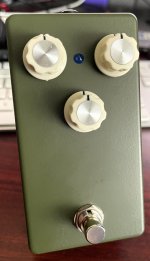MichaelW
Well-known member
- Build Rating
- 5.00 star(s)
Well, believe it or not, I've been working on this pedal for 3 days, finally buttoned it up.
Been a bit crazy at work past week or so.
I've always been intrigued with Pete Cornish pedals, probably partly of the association with David Gilmour, and partly because I'd never pay the crazy retail prices for one even if I could find one.
But somehow for the most part they've failed to have much holding power for me. I think my favorite one so far is the OC-1 Compressor. Maybe followed closely by the CC-1 overdrive.
I was stoked about the G2 and P2 from @Fingolfen's posts and ordered the board. I had high hopes for the G2 but to be honest I'm just not feeling it.
It's a very warm to dark pedal, to the point that it feels like I did something wrong. Sounds a bit like a muffled Big Muff unless I crank the tone knob then also boost it with the Particle Accelerator with the treble and mid knobs cranked. I recall there was a post about some cap substitutions to open it up. Which I may try. I think it was in the Aion build docs.
At lower gains, it can sound kinda cool with a strat but the gain (Sustain) comes on pretty quickly and it get's pretty wooly.
As I'm looking at the P2 board it looks almost identical but since that's marketed as a true "fuzz" I'm hoping for better results with that one when I get to building it.
Like most Cornish pedals, this one is buffered bypass, and it's got its share of typically Cornish goofy component values. (Like an A47k gain pot.....wtf?)
The output is pretty low on this pedal, most likely due to the quad of GE diodes. Unity gain is around 2 o-clock or so depending on where the sustain knob is set.
I used my favorite 1N34A substitutes, the ITT Red Band Cathode diodes. They all measured in the "Klon range".
I would agree with @Fingolfen's review that this is a niche pedal. There's some cool sounds in it, but I'm not feeling the whole Gilmour thing, which is the main reason for building this. Looking forward to seeing how the Polonium sounds!
Or.......I'll update this post if I wind up doing some of the mods.
5 Stars for build experience, typical PedalPCB symmetry. 1 star for me for not doing more research on this pedal before committing to it.....


Been a bit crazy at work past week or so.
I've always been intrigued with Pete Cornish pedals, probably partly of the association with David Gilmour, and partly because I'd never pay the crazy retail prices for one even if I could find one.
But somehow for the most part they've failed to have much holding power for me. I think my favorite one so far is the OC-1 Compressor. Maybe followed closely by the CC-1 overdrive.
I was stoked about the G2 and P2 from @Fingolfen's posts and ordered the board. I had high hopes for the G2 but to be honest I'm just not feeling it.
It's a very warm to dark pedal, to the point that it feels like I did something wrong. Sounds a bit like a muffled Big Muff unless I crank the tone knob then also boost it with the Particle Accelerator with the treble and mid knobs cranked. I recall there was a post about some cap substitutions to open it up. Which I may try. I think it was in the Aion build docs.
At lower gains, it can sound kinda cool with a strat but the gain (Sustain) comes on pretty quickly and it get's pretty wooly.
As I'm looking at the P2 board it looks almost identical but since that's marketed as a true "fuzz" I'm hoping for better results with that one when I get to building it.
Like most Cornish pedals, this one is buffered bypass, and it's got its share of typically Cornish goofy component values. (Like an A47k gain pot.....wtf?)
The output is pretty low on this pedal, most likely due to the quad of GE diodes. Unity gain is around 2 o-clock or so depending on where the sustain knob is set.
I used my favorite 1N34A substitutes, the ITT Red Band Cathode diodes. They all measured in the "Klon range".
I would agree with @Fingolfen's review that this is a niche pedal. There's some cool sounds in it, but I'm not feeling the whole Gilmour thing, which is the main reason for building this. Looking forward to seeing how the Polonium sounds!
Or.......I'll update this post if I wind up doing some of the mods.
5 Stars for build experience, typical PedalPCB symmetry. 1 star for me for not doing more research on this pedal before committing to it.....




